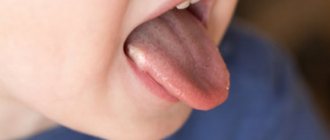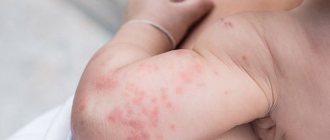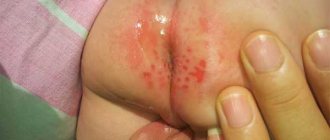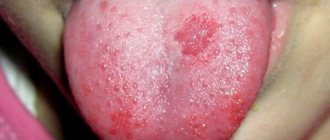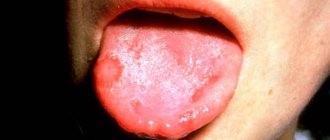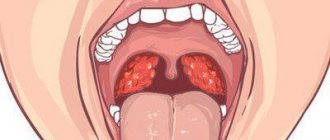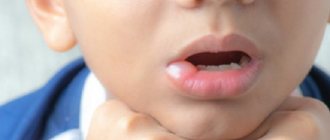Possible causes of tongue ulcers in children
In most cases, the appearance of ulcers on the tongue in childhood signals the development of some disease in the body. Such a pathological process can be localized not only in the oral cavity, but sometimes affects the digestive organs.
Rashes accompanied by pain and discomfort often occur against the background of the following pathologies:
- Dysbacteriosis.
- Allergy.
- Disturbances in the gastrointestinal tract.
- Infectious diseases: diphtheria, scarlet fever, measles.
- Pathologies of the circulatory system.
- Candidiasis.
- Types of stomatitis.
- Glossitis.
- Caries.
- Pulpitis.
In children, the most common cause of mouth ulcers is stomatitis. As a rule, this pathology develops against the background of vitamin deficiency or intestinal dysfunction.
In addition, mechanical damage to the mucous membrane of the tongue can provoke a pathological process; it includes the following:
- poor oral hygiene;
- cheek biting;
- physical injuries;
- using a hard toothbrush;
- recently erupted teeth with sharp edges that touch the mucous membrane of the tongue;
- excessive consumption of flour and sweets;
- consequences of taking certain medications;
- the predominance of foods high in acids in the diet;
- thermal or chemical burns from eating too hot foods.
The localization of ulcers helps determine the etiology of the disease. Their location on the sides or on the tip of the tongue may be a consequence of mechanical injury. But sometimes similar phenomena are observed in children after contact of the oral mucosa with dirty hands or objects, which confirms the presence of infection. Experts often consider rashes at the base of the organ as a consequence of disturbances in the functioning of the gastrointestinal tract and other serious changes.
Treatment of affected areas
The goal of any treatment is to alleviate the patient’s condition and completely get rid of the disease and its symptoms.
If ulcers in a child’s mouth are caused by mechanical damage, then treatment consists of removing the foreign object and treating the injury site.
In case of a chemical burn, it is necessary to wash the damage with soapy water, a solution of soda or citric acid. In case of arsenic exposure, the mouth is treated with a 1% solution of Iodinol or 5% Unithiol.
Complex therapy
But more often, ulcers and pimples in the mouth appear as a result of a local or systemic disease. In this case, complex therapy is used:
- local antiviral and painkillers, for example, Zovirax ointment, Arbidol, Vinilin and others;
- rinsing with a herbal solution or antiseptic;
- antipyretic medications;
- drinking plenty of water;
- in the chronic form of stomatitis, a complex effect on the body is required;
- in the case of bacterial types of disorders, the use of antibiotics and anti-allergenic drugs is necessary;
- in any case, taking vitamin complexes and maintaining hygiene are required.
If the appearance of ulcers is provoked by the presence of general diseases, therapy aimed at suppressing ulcerative formations should be carried out in conjunction with the treatment of the underlying disease as a provoking element.
Traditional medicine
Also, treatment of mouth ulcers in a child can be carried out using traditional medicine.
Among the many recipes tried by traditional healers, the following stand out:
- a mixture of 1/2 glass of milk with an yolk, plus a dessert spoon of honey, this liquid is used to wipe the entire oral cavity daily, recovery occurs on the 3rd day;
- wounds are also treated with a mixture of chopped almonds and honey;
- Calendula decoction prepared in a water bath is an excellent mouth rinse;
- For rinsing, a decoction of cinquefoil, elecampane, saline solution, and thyme herb are also used;
- chicken protein diluted in 100 ml of water, used for rinsing every 2 hours;
- for 3 weeks, take yarrow juice with honey, 3 tablespoons daily;
- if the ulcers really torment the baby, you can use a mixture of chamomile, calendula and linden flowers to rinse;
- Treating with peroxide and using horseradish with carrot juice helps a lot.
Read also: Black teeth in a child
Aphthous stomatitis
The pathology is manifested by the spread of ulcers on the tongue of a round shape. At first they have a red tint, and later become covered with a cheesy coating. The rashes are accompanied by pain, and when trying to eliminate them, the soft tissues bleed. This causes anxiety for the baby and makes it difficult to eat.
Doctors are still studying the origin of aphthous stomatitis, but it is generally accepted that the following can provoke the disease:
- Vitamin deficiency.
- Reaction to oral care products.
- Food allergies.
- Stress.
- Genetic predisposition.
As a rule, the duration of such stomatitis is about 10 days. But in the absence of proper treatment, the disease can take a severe form lasting up to 2 months.
Precautionary measures
Maintaining oral hygiene plays a big role in preventing the development of mouth ulcers
- Make sure your child maintains oral hygiene. This is especially true for brushing your teeth.
- Do not give children too hot or cold food.
- Make sure your baby chews food carefully.
- You should not feed your little one too hard foods.
- It is important that the child’s diet is balanced, enriched with all necessary vitamins and microelements.
- Try to protect your baby from the effects of stress factors, avoid conflicts in the family, and do not quarrel in the presence of the toddler.
- Visit your dentist regularly, at least twice a year. Often the appearance of ulcers on the gums is a consequence of a dental problem.
- Carry out procedures to strengthen the immune system.
- Adequate sleep and physical activity are of great importance for health.
- If any disease appears, you must consult a doctor promptly to prevent the development of chronic processes.
It is important to understand that the answer to the question of how to treat ulcers in a baby’s mouth should only be given by a doctor. It is unacceptable to self-medicate, as this phenomenon may indicate the presence of a disease that requires specialized drug therapy.
Allergic stomatitis
The cause of this stomatitis is the body’s reaction to an emerging allergen.
The following can provoke a pathological process:
- medicines;
- certain foods;
- oral hygiene products;
- dental materials: metal braces or fillings.
An allergic reaction is manifested by the formation of erosions and red spots that do not have clear outlines. Often the rashes affect not only the tongue, but the entire oral cavity, even the throat. Along with this, children may experience swelling of the face and lips. Unpleasant symptoms disappear within 3 days after the root cause, the allergen, is eliminated.
Treatment
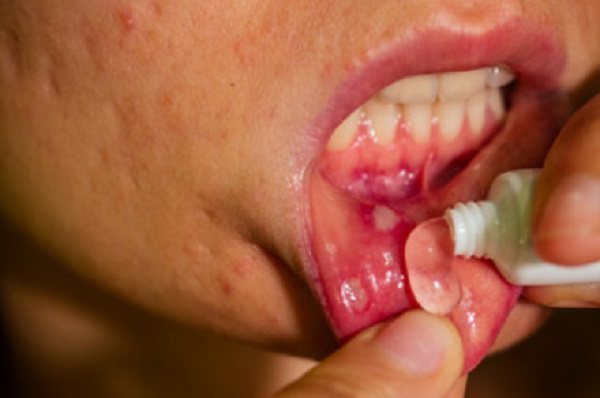
If a child develops a white sore in the mouth, it is imperative to consult a doctor. It is important to understand that what the treatment will be depends directly on the reasons that provoke the appearance of formations, since this is only a symptom of some ailment or a consequence of exposure to certain factors. Once the diagnosis is established, the specialist will prescribe appropriate therapy.
- If there are ulcers of viral etiology, the wounds are treated with a weak solution of potassium permanganate; Acyclovir or Zovirax can also be prescribed.
- If injury occurs, a specialist may prescribe painkillers, in particular Cholisal or Kamistad.
- If there is a fungal infection, Candizol or Clotrimazole may be prescribed.
- At high temperatures, medications based on paracetamol or ibuprofen are prescribed. These drugs may also be prescribed as analgesics.
- In case of an allergic reaction, use antihistamines, for example, Loratadine or Diazolin.
- For the speedy healing of wounds - Solcoseryl.
- Immunostimulants, for example, Arbidol or Viferon.
- For vitamin deficiency - complexes of vitamins with minerals.
- Mouth rinses, in particular 0.1 percent Miramistin or 0.5 percent Chlorhexidine.
It is important to observe the following features of caring for a child during the treatment of ulcers at home:
- do not give your baby hot, too cold or spicy food;
- it is important to reduce the amount of consumption of sweets and sugar in particular;
- it is necessary to ensure the presence of the correct drinking regime;
- try to feed your child crushed food, preferably pureed.
Traditional methods

Along with medications, the doctor may prescribe traditional medicine. However, it is important that these medications are prescribed by a doctor, since parents, unknowingly, can harm the child by giving him some medication that is not appropriate for his age or is not in the correct dosage. Therefore, self-medication is unacceptable.
- A decoction of sage, chamomile or calendula has a calming effect, relieves inflammation, and also has regenerating properties. Take a tablespoon of dried flowers, pour one glass of boiling water, and leave to steep for at least an hour. Then filter and use as a mouth rinse.
- Aloe juice. It is important to use fresh, in a small dilution with water, if it is used to lubricate wounds. It can also be used for rinsing, but you need to dilute a few drops of juice with a glass of water.
- A solution with salt and soda is used as an antiseptic. Take a teaspoon of soda and the same amount of salt, pour a glass of warm water. Rinse the mouth with the resulting solution.
- Potato compress has a wound healing effect. One tuber is grated on a coarse grater, the resulting pulp is applied to the affected area, left for 15 minutes, after which the mouth is thoroughly rinsed with warm water.
- Eucalyptus tincture helps relieve pain. Take the dried leaves of the plant, crush them, pour boiling water over them, and leave to infuse for at least three hours. You can also use a ready-made tincture purchased at a pharmacy. If this is your case, then a few drops of the tincture should be diluted with a glass of warm water. The prepared product is used to rinse the mouth four times a day.
- Propolis and honey can be used as immunostimulants.
Candidal stomatitis
Often, signs of candidiasis are observed in one-year-old babies. The causative agent of the disease is a fungus of the genus Candida. Most often, infection occurs through the mouth, when a child comes into contact with household objects or toys.
In addition, the following factors can provoke thrush:
- Taking antibiotics.
- Weakened immunity.
- Frequent hypothermia.
Thrush manifests itself as rashes on the oral mucosa of varying sizes. Such wounds are covered with a dense cheesy coating, spreading to the root of the tongue, gums and the inside of the lips. It is extremely rare for ulcers to bleed.
The following symptoms also indicate the presence of candidiasis:
- severe itching;
- bad breath;
- dryness of the oral mucosa;
- increased body temperature;
- swelling;
- cracks in the corners of the mouth.
At the onset of the disease, children experience restless behavior, sleep poorly and refuse to eat.
Other causes of mouth ulcers in children
Very often, ulcers in a child’s mouth indicate a pathology such as viral stomatitis. The culprit of the disease is the Coxsackie virus. The disease is accompanied by damage to the mucous membranes of the tongue, cheeks and pharynx with small yellowish ulcers, which cause the baby a lot of anxiety and pain.
The herpes virus is no less dangerous and occurs mainly in children aged 1 to 3 years. The baby is capricious, refuses to eat, and experiences pain in the mouth. There is also an increase in salivation, bad breath, and fever. Small blisters can be found on the mucous membrane, which quickly burst. After peeling off the yellowish-gray film on the affected areas of the mucous membrane, ulcers appear in the child’s mouth.
Dental defects are another common reason for the formation of ulcers on a child’s tongue. These mainly include dental caries and malocclusion. These factors can cause injury or irritation to the lining of the mouth and make it vulnerable to infection.
Vitamin C deficiency. With this disease, the gums become inflamed, bleed, swell and acquire a bluish tint.
Breathing through the mouth. In a child who breathes this way, the oral mucosa becomes loose, dry and bleeds easily. Grooves and ulcers appear on the tongue. These changes reduce the ability of the mucous membrane to fight various types of infections.
How to cure effectively
To eliminate ulcers on the oral mucosa and tongue in a child, it is necessary to find out the root cause of the pathological process. This is the only way to select adequate therapy. At the same time, the treatment course includes eliminating the symptoms that appear.
To do this, the following is recommended:
- Eliminate all factors causing mechanical damage to the oral mucosa.
- Improve hygiene.
- Avoid foods that cause allergies.
- Use solutions and gels for the oral cavity that reduce inflammation.
In addition to using prescribed medications and procedures, the following will help increase the effectiveness of treatment:
- teach your child how to brush their teeth correctly;
- sterilize children's dishes after eating;
- consult a doctor if new ulcers appear on the tongue;
- Consult a dentist if your teeth are growing abnormally and damaging the mucous membrane.
Ulcers that appear as a result of mechanical damage to soft tissue quickly heal on their own. There is no need for specific treatment.
Traditional methods
Traditional medicine recipes are effective in treating mild forms of stomatitis. To eliminate pain and discomfort in the mouth, the following compositions are used.
Turmeric paste. For preparation, honey and spice are used in a 1:1 ratio. The mixture is applied to the site of inflammation. This medicine has a pleasant taste, so children do not refuse to use it. Since bee products tend to cause allergies, their use is permissible in children from 12 months.
Thrush
Another name for this disease that affects the mucous membranes of the oral cavity is candidal stomatitis. This disease is caused by Candida fungi. They are present in the mouth, but under certain conditions multiply in large numbers and cause soft tissue infection.
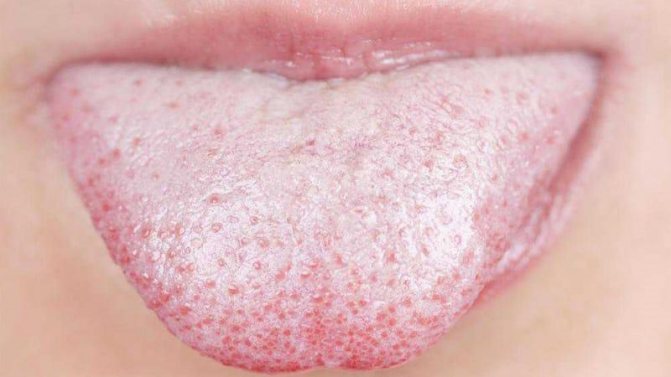
Signs of thrush in children
Most often, children under one year of age suffer from this disease. Every mother needs to know when she notices white ulcers on her child’s tongue, how to treat such manifestations, and what other symptoms are characteristic of thrush. These wounds may become covered with a clearly visible light yellow coating. Sometimes they bleed. The child feels itching and discomfort. In this case, a white coating often appears on the tongue, the inside of the lips and gums.
How to cure effectively
The following procedures are recommended:
- Apply a gel with an anesthetic effect to the sores . The baby should be fed.
- Take a clean piece of gauze, squeeze out a small amount of an antifungal agent, for example, fluconazole or nystatin, onto it, cover the damaged areas in the baby’s mouth, while removing white plaque .
This therapy is prescribed three or four times a day. In this case, you should wait at least 30 minutes after treating the wounds before eating.
In case of relapses, when stomatitis can return several times a month and does not cure for a long time, it is necessary to urgently consult a doctor
What is the danger of tongue ulcers?
Sores on the tongue or mouth are not harmless. In the absence of proper treatment, the disease becomes severe and poses a health hazard. In this case, it will take more time to eliminate the disease.
Untimely treatment of wounds on the tongue and oral mucosa increases the risk of infection through dirty hands and objects.
Most often in children, pathology manifests itself with the following complications:
- Attachment of a secondary infection.
- Spread of inflammation to the skin of the face or internal organs.
- Feverish condition.
- Colitis.
- Signs of body intoxication.
- Liver disorders.
- Convulsive phenomena.
- Damage to the nervous system.
If the inflammation progresses, the child has no appetite and drinks little fluid. As a result, the body suffers from exhaustion and dehydration. In practice, cases have been recorded in children where infection of the oral cavity ended in death.
Associated symptoms
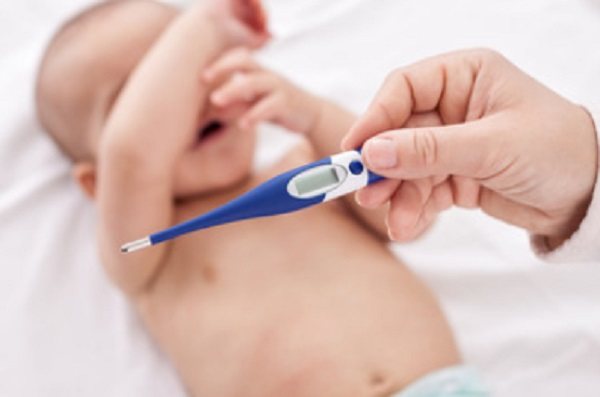
Mouth ulcers may be accompanied by a rise in temperature
The appearance of ulcers may be accompanied by certain symptoms indicating the presence of an inflammatory process:
- swelling of the gums;
- chills;
- headache;
- nausea;
- high body temperature;
- enlarged lymph nodes;
- burning in the mouth;
- feeling of dry mouth;
- pain when swallowing.
Based on the presence of certain accompanying symptoms, one can suspect the presence of a particular disease:
- with herpes, there may be a high temperature, a rash in the form of blisters, and painful ulcers;
- with candidiasis, there is a whitish coating on the tongue or palate, pain, a cheesy coating, and high temperature may be noted;
- if the appearance of ulcers is the result of an injury, then a hematoma, redness, or abscess may be observed;
- in acute gingivostomatitis, white ulcers may be present on the cheeks, palate, and tonsils.
It is important to know about warning signs, if present, you should not delay a visit to the doctor:
- pain syndrome that persists even after taking analgesics;
- elevated temperature that cannot be brought down by antipyretics;
- low blood pressure, general weakness;
- the appearance of bleeding in the oral cavity, which cannot be stopped.
